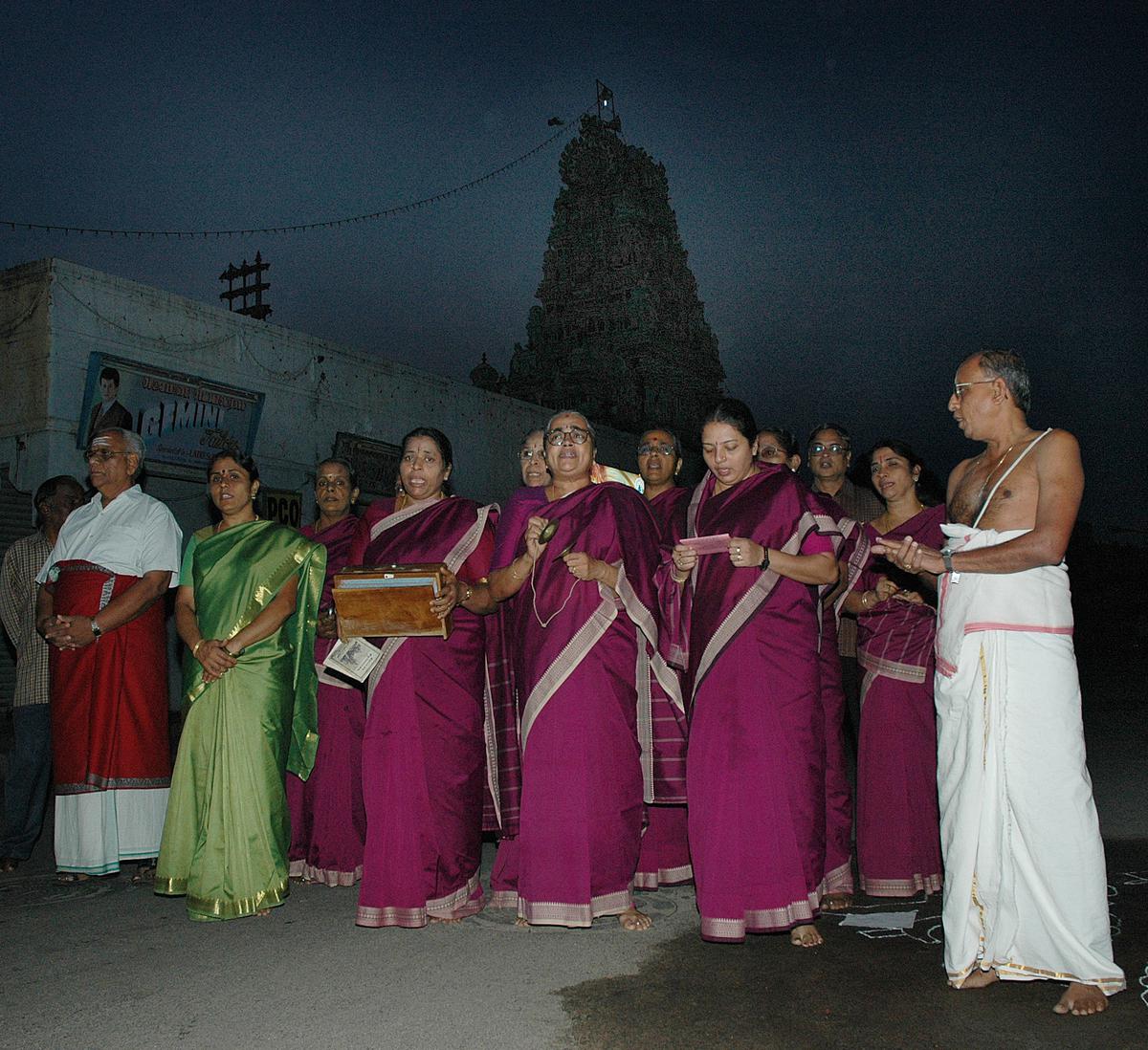Naaham vasaami vaikunte, na yogi hridaye ravau;
Madhbhaktha yatra gaayanti, Tatra tishtami Narada
(I dwell not in Vaikunta, nor in the hearts of the yogis. O, Narada, I am present where my devotees sing and chant), said the Lord, who also said that He was Margazhi among the months. This is the very core of the philosophy of Namasankirtanam.
Dhanur masa or Margazhi derives its name from the star Mrigashirsha and is associated with devotional spirit. Temples open at pre-dawn hours, devout chant rhe Tiruppavai and Tiruvempavai verses, and in small towns, the songs are still amplified by speakers waking up the neighbourhoods.
Margazhi is also a time when bhajan groups walk through the streets of Mylapore, north Chennai and towns such as Tiruvaiyyaru, where the front yard of houses sparkle with freshly-drawn kolams. The group singing, to the accompaniment of the chapla kattai (wooden cymbals), harmonium and mridangam, lends a divine touch to the cool mornings, with the breeze carrying a welcome mixture of sounds.
Unchavriti bhajan at Sri Thiagaraja Sangeetha Vidwath Samajam in Mylapore, Chennai, in 2017.
| Photo Credit:
K.V. SRINIVASAN
The bhajan sampradaya began about 500 years ago by Sri Chaitanya Mahaprabhu of Bengal. In the South, about 350 years ago, in Govindapuram near Tiruvidaimarudur, known as Madhyarjunam, Sri Bhagavan Nama Bodhendral and his contemporary, a great devotee Sridhara Venkatesa Ayyaval, who lived close to Tiruvisainallur, wrote several granthas and established the Nama Siddhanta.
Around 250 years ago, in Marudanallur, also known as Brahmapuram and Madananthapuram, Venkatarama Swamy, better known as Sadguru Swamigal, established the Hari-Hara bhajan system, now prevalent in the South. These three are considered the Mummurthy (triumvirate) of Sampradaya Namasankirtanam.
At Marudanallur, during the time of Sadguru Swamigal, daily bhajan (namasankirtanam) used to be held in the evenings, followed by Dolotsavam. Unchavritthi was part of the daily schedule. During Saturdays and Ekadasi, special namasankirtanams were held. Veedhi bhajanais with devotees from neighbouring villages were regular events. A math where Sadguru Swamigal used to stay still exists.
The Tyagaraja connect
Saint-composer Tyagaraja pointed to the easier Gana Marga, of course, centered around Bodhendral’s precept of nama japa. The bard of Tiruvaiyaru was a spiritual singer and lived a life of unchavritti — one of austerity, rigour and discipline. He went around the streets singing namasankirtanam. He refers to this in his kriti, ‘Haridasulu Vedale.’ The value of nama japa is also stressed in his ‘Namakusumamula’ and ‘Bhajana seyave.’ It cannot be gainsaid that the Bhagavatha tradition has earned substantially from Tyagaraja’s Divya Nama Sankirtanas and Utsava Sampradaya kirtanas. Narayana Tirtha describes the Lord as ‘Sangeetha rasa rasika’. This underlines the importance of pleasant music in namasankirtanam.
How it began
Seshachari, a lawyer, philanthropist and a close friend of Annie Besant, started Margazhi veedhi bhajanai on the Mada Streets of Mylapore by the end of the 19th Century. The Umayalpuram Brothers, Sriperumbudur Mudumbai Krishnamachariar, K.C. Adivarahachariar, Thuraiyur Rajagopala Sarma and Mannargudi Sambasiva Bhagavatar were regular participants.
Papanasam Sivan was a member of this bhajan group before he started one in the 1930s. He continued to conduct Veedhi bhajanai during Margazhi and the Arubatthumoovar festival until he passed away in 1973. Sivan’s Veedhi Bhajanai is still being continued by his descendants and disciples.
Pudukkottai Gopalakrishna Bhagavathar (1892-1971) enriched the Sampradaya Bhajan tradition by travelling throughout the country, leading several congregations.
Nott Annaji Rao, a noted Bhagavatha and an ardent disciple of Swami Gnanananda Giri of Thapovanam, initiated Margazhi bhajanai in the middle of the last century and continued it until 1967, when his eminent son Swami Haridas Giri took over. If namasankirtanam is a transcontinental movement today, the credit goes to Swami Haridas Giri.

Thiruppavai chanting by a group of women in the early hours of Margazhi in Triplicane, in 2004.
| Photo Credit:
K.V. Srinivasan
Among those who popularised and patronised bhajan sampradaya, the names of Tiruvidaimarudur Venkatarama Bhagavathar, Kumbakonam Balu Bhagavathar, Srivanchiyam Ramachandra Bhagavathar, Mayavaram Krishnamurthy Bhagavathar, Pudukkottai Sanjivi Bhagavathar,Srirangam Sethumadhava Rao, T.V. Narayana Sastri, T.S. Krishnamurthy, Tiruchi Pichai Bhagavathar, A.K. Gopalan and Sethalapathi Balu deserve special mention.
As times change, the sampradaya bhajan too is metamorphosing. The younger generation of bhagavathars is taking this art online and to a larger audience.
(The Chennai-based is a Namsankirtana artiste and a disciple of Sadguru Nathamuni Nanaji Swamigal)